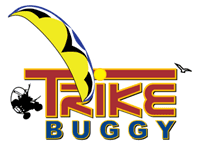

TrikeBuggy has a complete syllabus and practical training course focused on the PPG Trike!Our certified instructors will take you from the simulator to the skies using our "Natural Progression" learning technique, where you master each skill before moving on to the next.
We will then determine if there is any wind, and lay the canopy out on the ground facing the direction the wind is coming. Once we attach the trike to the risers and put our helmets on, we will seat ourselves in the trike and do a preflight check.
Your instructor has been evaluating the weather all morning, and will determine whether it is appropriate for you to fly. After a breifing of the launch, review of your flight plan and discussion of the approach and landing, it's time to set up for your flight. When you can consistently bring the glider overhead, "contact" the wing using the brakes, and control the direction of travel while taxiing forward into the wind, you will be rewarded by being lifted gently off the ground as the wing gains airspeed.
You may want to have someone come along to take pictures of you. We've seen some pretty big smiles and bright eyes after a pilot's first solo flight! It will be an experience you will never forget!
Our trained, Certified Wheel Launch Instructors are located all across America! Email us today to find out how easily it is to get your knees into the breeze!
"When once you have tasted flight,
|
|
|
|---|
|
DISCLAIMER: Please read and be sure you thoroughly understand this disclaimer before flying a TrikeBuggy. Trike flying is an extremely demanding sport requiring exceptional levels of attention, judgment, maturity and self discipline. It is unlikely that you will be able to participate in it safely unless you make a conscious and continual commitment to your own safety. PPG and Hang Glider Trike flying is a dangerous sport and may result in injury and death even when practiced by a competent pilot using proper equipment. TrikeBuggies are not covered by product liability insurance, nor have they been designed, manufactured or tested to any federal or state government airworthiness standards or regulations. Do not fly them unless you are willing to assume personally all risks in the sport of Trike flying, and all responsibility for any property damage, injury, or death which may result from your use of this TrikeBuggy. Safe operation of the TrikeBuggy requires a pilot proficiency equivalent to that of a BFI (Basic Flight Instructor), as well as an equivalent level of knowledge and understanding of those wind and weather conditions which may compromise the pilot's safe control of the TrikeBuggy. In particular, be advised that gusty winds or turbulent conditions may interfere with even an expert pilot's ability to safely control the TrikeBuggy, and may cause it to crash. Never take anything for granted in Trike Flying. If you are in doubt about anything, stop and figure it out or contact TrikeBuggy. Also please read our Warning and Caution! |